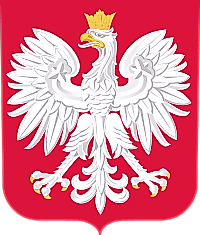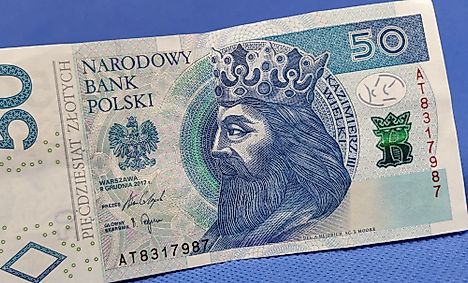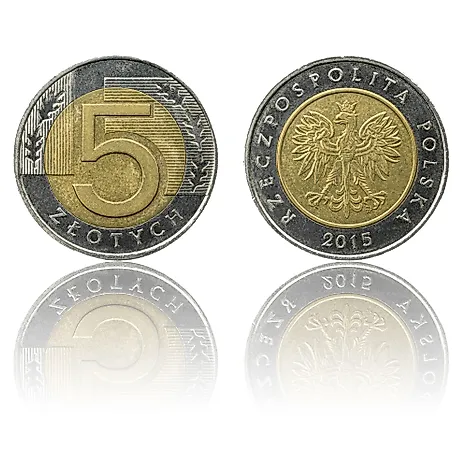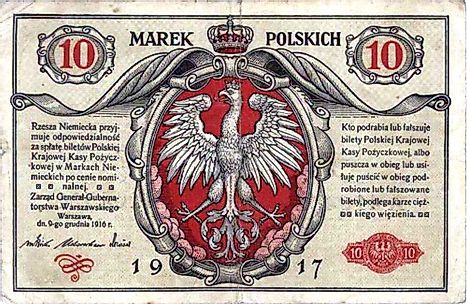Flags, Symbols & Currency of Poland

The National Flag of Poland was officially adopted on August 1, 1919.
The National Flag of Poland features two equal horizontal bands of white (top) and red. The flag colors have long been associated with Poland and its coat of arms. The white color represents the hope for peace by all the people of Poland. The red color symbolizes the many struggles for freedom over the centuries. The flag has a height-to-width ratio of 5:8.
History of the flag of Poland
Several different flags have been used in Poland before the current flag was adopted. In 1138, the Kingdom of Poland was made up of several duchies, each of which had its banner. In 1320, Poland became unified under King Wladyslaw, whose coat of arms consisting of a white eagle with a crown on its head, was used as the national symbol. In 1569, through the Union of Lublin, the Kingdom of Poland and the Grand Duchy of Lithuania united to become a commonwealth. The colors of the flag were adopted from the coat of arms of both the nations and consisted of the eagle of Poland and the mounted knight of the King of Lithuania. At the end of the 18th century, Austria, Russia, and Prussia collaborated to dissolve the commonwealth and break the union between Poland and Lithuania. Subsequently, Poland became a partitioned territory for the next 123 years. A new coat of arms was adopted by most of the partitioned regions, while some of them chose to retain the white eagle. During WWI, the German control over the Western-Polish Lithuanian region broke due to the Bolshevik Revolution, resulting in the crippling of Russia’s authority over the region. As a result, Poland became independent of these foreign powers. However, the previous red flag with the white eagle was rejected and a simple horizontal bicolor (white-red) flag was adopted as the national flag.
Symbols of Poland
The National Coat of Arms of Poland

The National Coat of Arms of Poland consists of a white eagle resting against a red shield. The eagle wears a golden crown and has a golden beak and talons. It also has outstretched wings and its head is turned to its right.
Legend has it that the founder of Poland - Lech, saw a white eagle's nest, and as he looked upon the bird, a ray of sunshine fell on its wings making it appear as if they were tipped in gold. Delighted, he decided to settle and made the eagle his emblem.
The current National Coat of Arms of Poland has been designed by Professor Zygmunt Kaminski.
National Anthem
- Anthem Title: "Mazurek Dąbrowskiego" ("Poland Is Not Yet Lost")
- Music Composer: Unknown
- Lyricist: Józef Wybicki
- Date of Adoption: 1926
"Mazurek Dąbrowskiego" ("Poland Is Not Yet Lost") is the national anthem of Poland. The music composer of the anthem is still unkown and the music is probably based on a traditional folk song. The lyrics of the anthem have been penned by Józef Wybicki. The anthem was officially adopted in 1926.
"Mazurek Dąbrowskiego" (Polish)
Jeszcze Polska nie zginęła,
Kiedy my żyjemy.
Co nam obca przemoc wzięła,
Szablą odbierzemy.
Chorus:
Marsz, marsz, Dąbrowski,
Z ziemi włoskiej do Polski.
Za twoim przewodem
Złączym się z narodem.
Przejdziem Wisłę, przejdziem Wartę,
Będziem Polakami.
Dał nam przykład Bonaparte,
Jak zwyciężać mamy.
Chorus
Jak Czarniecki do Poznania
Po szwedzkim zaborze,
Dla ojczyzny ratowania
Wrócim się przez morze.
Chorus
Już tam ojciec do swej Basi
Mówi zapłakany –
Słuchaj jeno, pono nasi
Biją w tarabany.
Chorus
"Poland Is Not Yet Lost"
Poland has not yet perished,
So long as we still live.
What the foreign force has taken from us,
We shall with sabre retrieve.
Chorus:
March, march, Dąbrowski,
From Italy to Poland.
Under your command
We shall rejoin the nation.
We'll cross the Vistula, we'll cross the Warta
We shall be Polish.
Bonaparte has given us the example
Of how we should prevail.
Chorus
Like Czarniecki to Poznan
After the Swedish annexation,
To save our homeland,
We shall return across the sea.
Chorus
A father, in tears,
Says to his Basia
Listen, our boys are said
To be beating the tarabans.
Chorus
The Currency of Poland is the Polish złoty
The current official currency of Poland is Polish złoty (zł, PLN). The Polish złoty is subdivided into 100 groszy (cents). In 1990, Poland redenominated the złoty, where, one new złoty was equal to 10,000 old złotys. The National Bank of Poland, the country's central bank, is responsible for producing and maintaining the stability of the złoty. In 1990, a fourth version of the złoty was introduced and is the country's current currency. Coins were minted in 1994 and circulated in 1995.
Coins
The current version of polish złoty coins were first minted in 1990, but not circulated until 1995. There are one hundred groszy (gr) to one złoty (zł). The coins in circulation are the one grosz, two grosze, five groszy, ten groszy, 20 groszy, 50 groszy, 1 zł, 2 zł, and 5 zł.
Banknotes
Unlike the minting of coins, the production of banknotes posed a bigger challenge. In 1990, a new version of the banknotes was printed in the denominations of 10 zł, 20 zł, 50 zł, 100 zł, and 200 zł. In 2012, the National Bank of Poland introduced a new feature on its banknotes. Apart from the new feature, everything else remains the same except for the 200zł note, whose color was changed.
Historical currencies of Poland
During the 14th and 15th centuries, any foreign gold currency that was used in the duchies of Germany and Ruthenia was known as zloty. Poland created a national currency in 1496, that was equivalent to 30 groschens of Prague and known as Polski zloty (golden Polish). Under the rule of Stanislaw August Poniatowski in the 18th century, the zloty became the official currency. It was replaced by the Russian rouble from 1850-1917 and by the Polish mark from 1917-1924. After WWI, the resulting economic crisis and hyperinflation led to the reintroduction of the zloty. After undergoing several devaluations, a new zloty was introduced in 1950 (PLZ) that equaled 100 old zloties. Again due to hyperinflation and subsequent decimalization, a new zloty (PLN) was introduced, where 10,000 old zloties (PlZ) equaled 1 new zloty (PLN).














